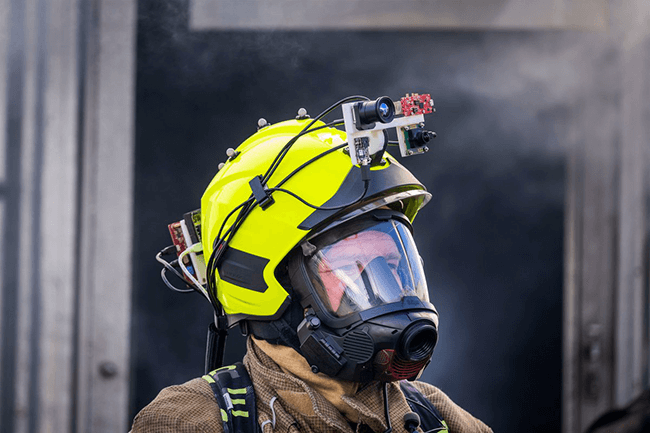Researchers Develop AI-Powered Helmets for Firefighters
17-10-2022 | By Robin Mitchell
Recently, researchers have demonstrated the potential capabilities of integrating AI into firefighter helmets with reduced time finding people through thick smoke, identifying hotspots, and aiding navigation. What challenges do firefighters face, what did the researchers develop, and how could smart technologies help search and rescue in the future?
What challenges do firefighters face?
Keeping fires under control is an important job for firefighters, but by far, the most critical role is to save lives. If need be, it is the responsibility of a firefighter to put themselves in harm’s way to find those who may be trapped in a burning building. Even with the best equipment, firefighters must navigate through some of the worse conditions imaginable, and failure to do so correctly will most likely cost lives.
A building on fire is undoubtedly extraordinarily hot, approximately 600˚C and the equipment worn by firefighters must be able to withstand this temperature for extended periods. If this equipment fails, hot air and debris can quickly rush into the suit, resulting in severe injury and/or death.
At the same time, the air inside a fire is filled with numerous amounts of toxic compounds, soot, and smoke that can all cause numerous short-term and long-term effects. In fact, just a small amount of exposure to smoke can set in dizziness as well as impede judgement. As such, it is imperative that firefighters carry oxygen in worn tanks with breathing equipment to limit exposure to the environment as much as possible.
The smoke from a house fire also causes challenges when navigating. Since homes are full of plastic and chemical compounds, smoke can quickly become opaque, making navigation extremely challenging. Furthermore, the intense sound from burning materials can make it hard to hear those in distress.
Finally, buildings on fire quickly become structurally unstable. That is why one of the first things that firefighters do when entering a building is to blast water at ceilings as it causes the plaster to fall and collapse (this prevents ceilings from unsuspectedly collapsing on the crew after water is used to fight a fire).
As the fire burns away at supporting structures and weakens beams, firefighters must be careful about where they step and the condition of a room. If a fire is allowed to heat up a room with no oxygen access, firefighters must be careful about backdraft, whereby the sudden introduction of oxygen causes an explosion.
Researchers integrate AI into firefighting equipment
Recognising the challenges firefighters face, researchers from National Robotarium in Edinburgh recently announced the development of a firefighter helmet that integrates numerous technologies to help firefighters find those trapped in dangerous environments. By integrating RADAR, thermal cameras, and multiple sensors, the helmet developed by the researchers can help firefighters effectively see through smoke and fire. To improve the helmet’s functionality, the researchers also integrated AI technologies to help the system make better sense of the environment being monitored. Furthermore, the use of mapping technologies also allows firefighters to determine where they have already been (so that they can minimise checking the same area twice), and this data can potentially be transmitted to all other firefighters to provide joint mapping.
To develop the technology, the researchers have been working with the Scottish Fire and Rescue Service to better understand the needs of firefighters, the nature of the environments they operate in, and how firefighters would want such a system to work. While the device is crude in design (numerous modules connected together via bulky cables), the overall weight is less than 1KG, which can be easily distributed across a helmet. If the technology can be custom adapted for a helmet (with proper protections and installation), then it could be ready for testing in real-world scenarios.

How can smart technologies help search and rescue in the future?
Smart technologies present those in search and rescue with numerous opportunities and will likely become central in such operations. By far, the most significant advantage of smart technologies in search and rescue is the ability for datacentres to examine huge amounts of data in a short time. For example, an individual lost at sea would be virtually impossible to find by eye through satellite photos, but an AI running on a data centre could easily go through every picture and not only identify anomalies but also find these anomalies based on predictive patterns and behaviour (such as ocean currents and wind directions).
At the same time, smart technologies installed in drones could allow search and rescue to cover large areas without any human intervention, while the use of RADAR and LiDAR can help to quickly find signs of life, including tracks, camps, and even smoke from fires. The fast deployment of such drone swarms also allows for fewer people (which is costly and time-consuming), which helps to cover more dangerous terrain such as cliffs, mountains, and canyons.
Overall, smart technologies present numerous advantages in the field of search and rescue, and what the researchers have demonstrated with the firefighter’s helmet is just another small step in the direction of intelligent rescue operations powered by AI.

